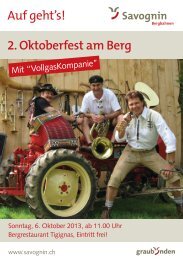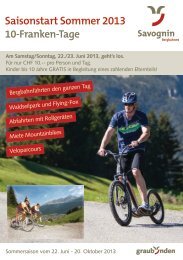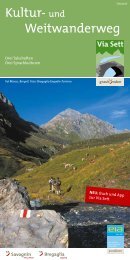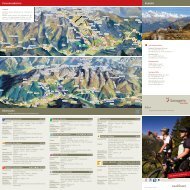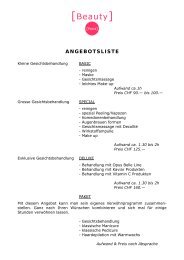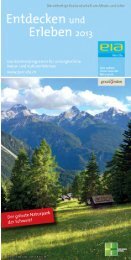Spassegio cultural tras vischnanca - Savognin
Spassegio cultural tras vischnanca - Savognin
Spassegio cultural tras vischnanca - Savognin
Create successful ePaper yourself
Turn your PDF publications into a flip-book with our unique Google optimized e-Paper software.
Nr. 1: Tourism and Giovanni Segantini<br />
The beginnings of tourism and Giovanni Segantini<br />
Traces of roman roads on the Julier Pass and Septimer Pass prove<br />
that both these passes were already in use in ancient times. After<br />
a large famine at the beginning of the 19th century the road<br />
over the Julier Pass was further developed in the years 1820-<br />
1840. With the beginning of tourism in the Engadin valley in<br />
the second half of the 19th century the traffic started to increase<br />
heavily. Traveling by horse and carriage or by foot was strenuous<br />
and slow. To offer accommodation and meals to the travelers,<br />
the hotels Piz Mitgel and Pianta were built around 1870. In the<br />
beginning the post and telegraph offices were located at the<br />
hotel Piz Mitgel and later moved to the Pianta family. <strong>Savognin</strong><br />
was advertised as a climatic spa at those times and many inhabitants<br />
found work and income through tourism in the valley and<br />
in the nearby Engadin.<br />
rides were counted and in winter 2010/2011 2‘060‘267 rides.<br />
Similar to the development of the ski lifts was the increase in<br />
the overnight stays. In 1962/1962 23‘301 overnight stays were<br />
counted. Today, 50 years later the number is around 300‘000<br />
overnight stays per year.<br />
The tourism created many new jobs and the emigration was<br />
stopped. Today about 1000 inhabitants are living in the village<br />
and several thousand guest beds are offered.<br />
To the right of the hotel Piz Mitgel you can see the Peterelli<br />
residence, where Giovanni Segantini, the famous painter of the<br />
Alps resided with his family from 1886-1894. On his journey<br />
from Italy he is said to have exclaimed «Che paradiso!» (what<br />
a paradise!). Our landscapes and the clear and clean light<br />
conditions inspired him so much that he decided to stay in the<br />
valley. During his time in <strong>Savognin</strong> he refined his painting skills<br />
and many famous paintings date from that period. The simple<br />
peasant life with its daily accomplishments and our beautiful<br />
landscapes, especially the views of the mountain range Piz<br />
Curver and Piz Toissa inspired the great painter and some of his<br />
paintings have achieved fame around the world.<br />
The Peterelli residence, the Veia Segantini, the Sala Segantini,<br />
the Pro Segantini foundation, the Plazza Segantini as well as the<br />
memorial stone at Tussagn, where he loved to linger to paint the<br />
Alps, commemorate his stay in <strong>Savognin</strong>.<br />
The family Segantini<br />
In the middle of the 20th century the emigration affected the<br />
valley strongly. In 1950, during the building of the Marmorera<br />
dam, <strong>Savognin</strong> counted 766 inhabitants. Ten years later the<br />
number was reduced to 632. In an advertisement in the newspaper<br />
«Neue Zürcher Zeittung» the community offered a developed<br />
piece of land above the larch forest for building, where the<br />
first holiday homes were built. The foundation of the Nandro ski<br />
lifts (today <strong>Savognin</strong> Bergbahnen) and the building of a chairlift<br />
as well as two ski lifts to the top of Piz Martegnas. In the first<br />
year of operation already 196‘067 passengers were handled.<br />
Ten years later over 2 million and around 1970 already 3 million<br />
passengers were handled per year. On march 4th 1976 the<br />
30 millionth‘ passenger was honored. In summer 2010 157‘675<br />
– 52 – – 53 –<br />
The first hotel brochures



